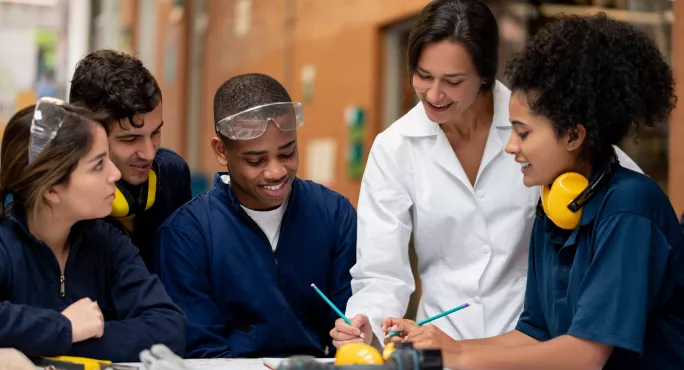Why we need to align workplace and classroom knowledge

The importance of sequencing and knowledge transfer for T levels and other vocational qualifications (part two).
In my last article, Why theory must come before practical lessons in FE, I tried to open up conversation and ignite discussion around the sequencing and transfer of knowledge in the vocational curriculum. This second part of this series considers the transfer of knowledge and its importance in developing a thoughtful workforce, which will allow the sector to meet the requirements of government agendas for “world-class skills” and produce a workforce that is able to make judgements in new and challenging situations.
The reason I focus on transfer of knowledge is that this is an issue that is viewed largely unproblematically in our sector. For example, look at our language and actions around the “delivery” of learning, or consider the models of professional development that involve sitting listening to an expert whose practice you are supposed to unproblematically transfer to your classroom. The implication behind both examples is that knowledge moves easily from one person to another and one context to another.
T levels: Placements unlikely in 2021, say employers
Kate Green: Post-16 plans ‘close the door on millions’
Boris Johnson: College masks rule to be lifted next week
However, when it comes to vocational knowledge, this is far from straightforward. At its most basic level, the knowledge used in a workplace has different purposes and aims than the knowledge contained in a syllabus. The former is likely to have developed within a context of a workplace. It is learned through mechanisms such as experience, observation and practical judgements, and its purpose is likely to be the achievement of workplace missions and vision.
T levels: Transferring classroom knowledge to the workplace
Curriculum or syllabus knowledge, on the other hand, is likely to be a mix of the types of workplace knowledge that can be written down and more formal academic knowledge. It will be learned through more formal pedagogies that look to bring together theory and practice, and its purpose is directed to the achievement of a qualification either to evidence the ability to progress to higher study or to evidence a level of understanding suitable to entry into a generic workplace.
What this mismatch means is that transfer of vocational knowledge is likely to be problematic. What it will require is what Bernstein calls recontextualisation, which is basically reshaping an idea or knowledge from one context to make it understandable or work in another. A good example is a DJ sampling a tune and using it in a completely different context.
One example I remember from teaching business was trying to teach the economic principle of the circular flow of money to students who don’t yet participate in the economy. The concept had no meaning to these 16-year-olds, which necessitated my turning it into a game with winners and losers in the classroom in order to give it some context from which the students could grasp the key principles.
David Guile and Karen Evans from UCL Institute of Education have done a lot of thinking in this space and they argue that there are “chains of recontextualization” required to bring together the workplace and the learning space. These chains of recontextualisation require thought about how to “move” the knowledge between the academic knowledge developing in universities and the college curriculum, the workplace and the curriculum (both from the curriculum to the workplace and vice versa) and how the learners’ existing knowledge and experience fits on top of this. Overall, what it suggests to me is that there is far more of a cognitive load in moving and recontextualising knowledge than seems to be suggested in policy.
On a practical level, what this means for qualifications like T levels, which aim to bring together these two types of knowledge, is that the curriculum may require aligning with what students do in the workplace with what they are learning in the learning space.
So, for example, there may be more thought given to what a student does on placement and when they do it, helping them to recognise and recontextualize the curriculum knowledge learned in the classroom. It will also require thought into how this workplace experience is then used in the classroom space, helping them draw links and reuse the knowledges of these two spaces. Put simply, “linking” these two spaces to facilitate transfer probably needs more consideration than it is presently given.
If we accept that the transfer of knowledge is cognitively more complex than we generally give credit for, then we can accept that it is unfair to leave this burden to a young and inexperienced individual. Shifting the entirety of this problem on to the curriculum designer is more work than can be reasonably achieved by individuals working in a time- and resource-constrained environment like further education. Instead, perhaps this is an issue to be considered and planned for at the level of policy and qualification, and so sits more with the scope of an awarding organisation than it may do any individual college, school or training provider?
Sam Jones is the chair of the steering committee at the Research College Group and founder of FEResearchmeet
You need a Tes subscription to read this article
Subscribe now to read this article and get other subscriber-only content:
- Unlimited access to all Tes magazine content
- Exclusive subscriber-only stories
- Award-winning email newsletters
Already a subscriber? Log in
You need a subscription to read this article
Subscribe now to read this article and get other subscriber-only content, including:
- Unlimited access to all Tes magazine content
- Exclusive subscriber-only stories
- Award-winning email newsletters